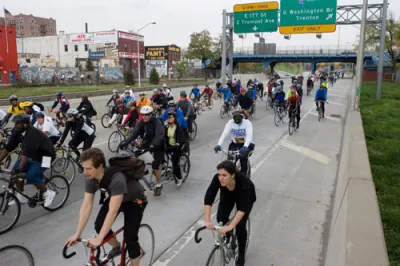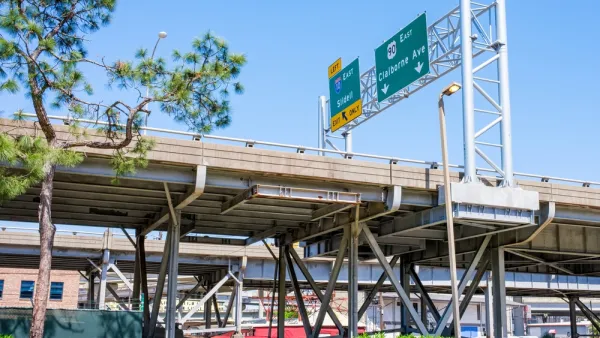Transportation Secretary Anthony Foxx sees rebuilding America's ailing infrastructure as an opportunity to "right past wrongs," particularly with 1950s and 1960s-era freeways that bisected communities. NPR and Streetsblog describe the new initiative.

Secretary Foxx tells NPR correspondent Brian Naylor how two interstate highways separated his childhood neighborhood in North Carolina.
"I didn't realize it as a kid; I didn't think about it as economic and psychological barriers but they were and the choices of where that infrastructure was placed in my community were not unique to Charlotte."
Naylor then turns to the legacy of controversial New York urban planner Robert Moses, "notorious for tearing up communities in the interests of the car, opposition be damned." Archival audio of Moses follows:
"Raw, categorical imperative is action to clear the slums and we can't let minorities dictate that this century-old chore will be put off another generation or finally abandoned," states Moses.
"Foxx says the highway barriers created by Moses and others were the result of deliberate decisions to route them through low income neighborhoods," states Naylor. "Now, decades later as infrastructure needs replacing or repairing, Foxx says there's an opportunity."
Naylor then turns to the Hunts Point section of the South Bronx, "a gritty neighborhood ringed by waste transfer stations...," where trucks pose "a constant threat on the local streets."
He interviews two community activists who describe the neighborhood division resulting from the Sheridan Expressway, an underused, 1.25-mile long stub built by Moses in 1963, that separates the community from an underused neighborhood park.
A 2010 post states that the expressway "has become a [national] battleground in a fight to take urban spaces back from the automobile."
Years of activism have paid off, states Naylor. Earlier in April the State of New York approved spending $97 million to convert the Sheridan Expressway into a boulevard "with crosswalks and bike paths."
On March 30, Streetsblog USA's Angie Schmitt wrote about the secretary's presentation to the Center for American Progress on the new initiative, called Ladders of Opportunity, "which aims to shape transportation policy based on how infrastructure can serve as a barrier, or bridge, to jobs, education, and better health."
The disparities go beyond highway planning. “Look at our basic sidewalk infrastructure,” Foxx said, pointing to a photo of the notorious Buford Highway in suburban Atlanta. “You see these roads are really designed for cars, not people. There are no sidewalks, and where you see sidewalks there are no crosswalks.”
A short (2:43-minute) video, "Bridging the Divide: Connecting People to Opportunity," is on the U.S. DOT webpage, Ladders of Opportunity.
Hat tips to Chuck Siegel and Larry Fox.
FULL STORY: Secretary Foxx Pushes To Make Transportation Projects More Inclusive

Analysis: Cybertruck Fatality Rate Far Exceeds That of Ford Pinto
The Tesla Cybertruck was recalled seven times last year.

National Parks Layoffs Will Cause Communities to Lose Billions
Thousands of essential park workers were laid off this week, just before the busy spring break season.

Retro-silient?: America’s First “Eco-burb,” The Woodlands Turns 50
A master-planned community north of Houston offers lessons on green infrastructure and resilient design, but falls short of its founder’s lofty affordability and walkability goals.

Test News Post 1
This is a summary

Analysis: Cybertruck Fatality Rate Far Exceeds That of Ford Pinto
The Tesla Cybertruck was recalled seven times last year.

Test News Headline 46
Test for the image on the front page.
Urban Design for Planners 1: Software Tools
This six-course series explores essential urban design concepts using open source software and equips planners with the tools they need to participate fully in the urban design process.
Planning for Universal Design
Learn the tools for implementing Universal Design in planning regulations.
EMC Planning Group, Inc.
Planetizen
Planetizen
Mpact (formerly Rail~Volution)
Great Falls Development Authority, Inc.
HUDs Office of Policy Development and Research
NYU Wagner Graduate School of Public Service



























